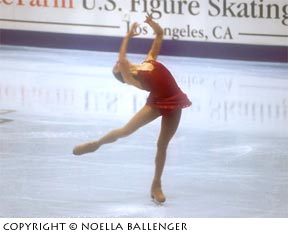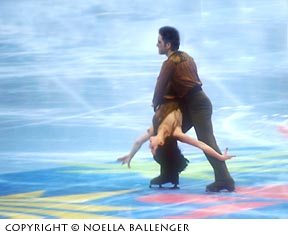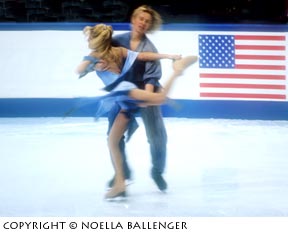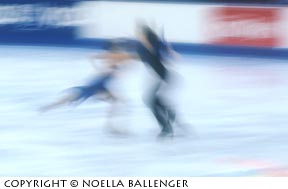
Photography doesn’t have to be super-serious all the time. Every now and again, I break out to do some “just for fun” photography. My serious work always benefits from the experience.
For example, a couple weeks ago, the United States Figure Skating National Championships were held in Los Angeles, California. A friend and I shared a pair of tickets for the entire week, and it was exciting to see the young athletes perform. After the first day, my friend asked me why I didn’t have my camera with me. Embarrassing to say, I just hadn’t thought of it. I specialize in nature–not people or sport events. The challenge was implied. I decided that the next day I would come with my camera and lots of film.
Later that evening, I tried to decide what equipment I would use. I didn’t want to carry too much with me, so I needed to choose carefully. I had my trusty camera with a 100-300 mm (F4-F5.6) zoom lens. My seat was in the twenty-fourth row up from the ice level, near a corner. (I could have moved closer for some events, but I chose to be lazy and let the lens do the work for me.) I also carried my 1.4 tele-extender, just in case. (I used it only once and wasn’t happy with it.) I didn’t want to bother with a monopod. A tripod in arena seats wouldn’t have been practical.

The ice rink presented several difficult problems—first, lighting and exposure. I couldn’t use flash, because it could disturb and possibly endanger the skaters. Fortunately, the rink ceiling was hung with powerful lights for the television crews, so there was plenty of light. The next problem was the dazzling bright, white ice. The lighting was even, so there weren’t any hard shadows or highlights. This situation was similar to snow in the bright (but not direct or harsh) sunlight. To keep the ice white, I had to overexpose by at least one stop. My basic exposure was taken from a neutral gray card.
Skaters move very quickly. I wanted to try my techniques of panning; slowing the shutter speed and letting the subjects blur themselves, and multiple exposures. I also wanted to capture some clear, crisp, straight photographs. I found out one fact almost immediately. Shooting sport events is tough work. I have far more respect and admiration for good sports photographers now. Just following the skaters on the ice and catching them in good positions was very difficult. I really needed a faster lens. Even by pushing the film one stop and keeping the lens at its widest aperture, I still didn’t have enough speed to freeze the action.

Focus was another challenge. I needed to use the largest aperture I could to keep the shutter speed up. That left me with no depth of field. My reflexes weren’t fast enough for me to manipulate the focus manually. The regular auto focus kept sliding back and forth as I panned or moved the camera with the skater. So, my solution was to pre-focus on an area, go onto manual focus, and photograph only when the skater entered my selected area. This technique worked best of those I tried–but not perfectly. I found myself going back and forth between all of my focus options. (I was lucky that I knew where the controls on my camera were located, how to flip them on or off quickly, and in which direction to turn things to achieve my desired result. You can’t practice with your camera too much!)
The results of my efforts provided some very worthwhile lessons. I was reminded that specialized areas of photography have their own challenges and skills to be mastered. Even if you’re a very good photographer, there’s always more work to do and more to learn. However, the challenge of trying something new and doing it just for fun brings a new awareness to your eye.

In addition, I learned a lot about motion—the motion of the skaters and my own motion. Following and stopping motion is difficult and takes better equipment than I had brought with me. But motion has a beauty of its own, and I really liked what I did when I simply slowed the shutter speed down and let the skater make the image. I found that jumps were extremely difficult to capture. Spins were much easier, because the better the spin, the less area it covers.
I think that panning steadily is difficult. I did a good job of it at the horse races on a lovely foggy morning, but my results weren’t as good at the skating rink. Sometimes my pans looked really ragged—as though Los Angeles were having another earthquake. I wasn’t smooth in my movement. I need to practice panning more.
My multiple exposures were a disappointment, because they looked thin, and there was too much movement. Also, in several shots, I tried zooming in so the size of the skater would vary with each exposure. This experiment didn’t work well, either, but I did get one or two images that I kept to remind me to try that idea again another time so I can master the technique.
In summary, I shot about eight rolls of film during the week. I discarded three or four rolls at the edit box. However, I kept some of my less than stellar results to remind me of lessons I have yet to learn. On the whole, the experience was very valuable. I had a wonderful time watching the skaters and trying to capture the essence of artistic motion on film. I rose to the challenge and learned more about the skills and techniques used by sport photographers. I came away with greater respect, understanding, and admiration for their superb photographs. I had a really great time doing something I seldom try, and I stretched my skills and my imagination.
The Winter Olympics are happening. And, as we all watch these events, start to look at the photography. Then, go to your local park, arena, or sporting event and try sports photography for yourself. The goal is to learn something new, try new techniques and–most importantly–have a super time!
by Noella Ballenger

Leave a Reply